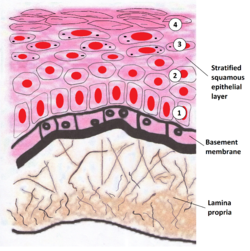Loading AI tools
Thin fibrous layer between the cells and the adjacent connective tissue in animals From Wikipedia, the free encyclopedia
The basement membrane, also known as base membrane, is a thin, pliable sheet-like type of extracellular matrix that provides cell and tissue support and acts as a platform for complex signalling.[1][2] The basement membrane sits between epithelial tissues including mesothelium and endothelium, and the underlying connective tissue.[3][4]
| Basement membrane | |
|---|---|
 The epithelium and endobasement membrane in relation to epithelium and endothelium. Also seen are other extracellular matrix components | |
 Image showing the basement membrane of the lining of the mouth, which separates the lining (epithelium) from a loose layer of connective tissue (the lamina propria) | |
| Details | |
| Identifiers | |
| Latin | membrana basalis |
| MeSH | D001485 |
| TH | H2.00.00.0.00005 |
| FMA | 63872 |
| Anatomical terms of microanatomy | |


As seen with the electron microscope, the basement membrane is composed of two layers, the basal lamina and the reticular lamina.[4] The underlying connective tissue attaches to the basal lamina with collagen VII anchoring fibrils and fibrillin microfibrils.[5]
The basal lamina layer can further be subdivided into two layers based on their visual appearance in electron microscopy. The lighter-colored layer closer to the epithelium is called the lamina lucida, while the denser-colored layer closer to the connective tissue is called the lamina densa. The electron-dense lamina densa layer is about 30–70 nanometers thick and consists of an underlying network of reticular collagen IV fibrils which average 30 nanometers in diameter and 0.1–2 micrometers in thickness and are coated with the heparan sulfate-rich proteoglycan perlecan.[6] In addition to collagen, this supportive matrix contains intrinsic macromolecular components. The lamina lucida layer is made up of laminin, integrins, entactins, and dystroglycans. Integrins are a key component of hemidesmosomes which serve to anchor the epithelium to the underlying basement membrane.
To represent the above in a visually organised manner, the basement membrane is organized as follows:
The primary function of the basement membrane is to anchor down the epithelium to its loose connective tissue (the dermis or lamina propria) underneath. This is achieved by cell-matrix adhesions through substrate adhesion molecules (SAMs).
The basement membrane acts as a mechanical barrier, preventing malignant cells from invading the deeper tissues.[7] Early stages of malignancy that are thus limited to the epithelial layer by the basement membrane are called carcinoma in situ.
The basement membrane is also essential for angiogenesis (development of new blood vessels). Basement membrane proteins have been found to accelerate differentiation of endothelial cells.[8]
The most notable examples of basement membranes is the glomerular basement membrane of the kidney, by the fusion of the basal lamina from the endothelium of glomerular capillaries and the podocyte basal lamina,[9] and between lung alveoli and pulmonary capillaries, by the fusion of the basal lamina of the lung alveoli and of the basal lamina of the lung capillaries, which is where oxygen and CO2 diffusion occurs (gas exchange).
As of 2017, other roles for basement membrane include blood filtration and muscle homeostasis.[1] Fractones may be a type of basement membrane, serving as a niche for stem cells.[10][11]
Some diseases result from a poorly functioning basement membrane. The cause can be genetic defects, injuries by the body's own immune system, or other mechanisms.[12] Diseases involving basement membranes at multiple locations include:
In histopathology, thickened basement membranes are found in several inflammatory diseases, such as lichen sclerosus, systemic lupus erythematosus or dermatomyositis in the skin, or collagenous colitis in the colon.[15]
These are only found within diploblastic and homoscleromorphic sponge animals. The homoscleromorph were found to be sister to diploblasts in some studies, making the membrane originate once in the history of life. But more recent studies have disregarded diploblast-homoscleromorph group, so other sponges may have lost it (most probable) or the origin in the two groups may be separate.
Seamless Wikipedia browsing. On steroids.
Every time you click a link to Wikipedia, Wiktionary or Wikiquote in your browser's search results, it will show the modern Wikiwand interface.
Wikiwand extension is a five stars, simple, with minimum permission required to keep your browsing private, safe and transparent.